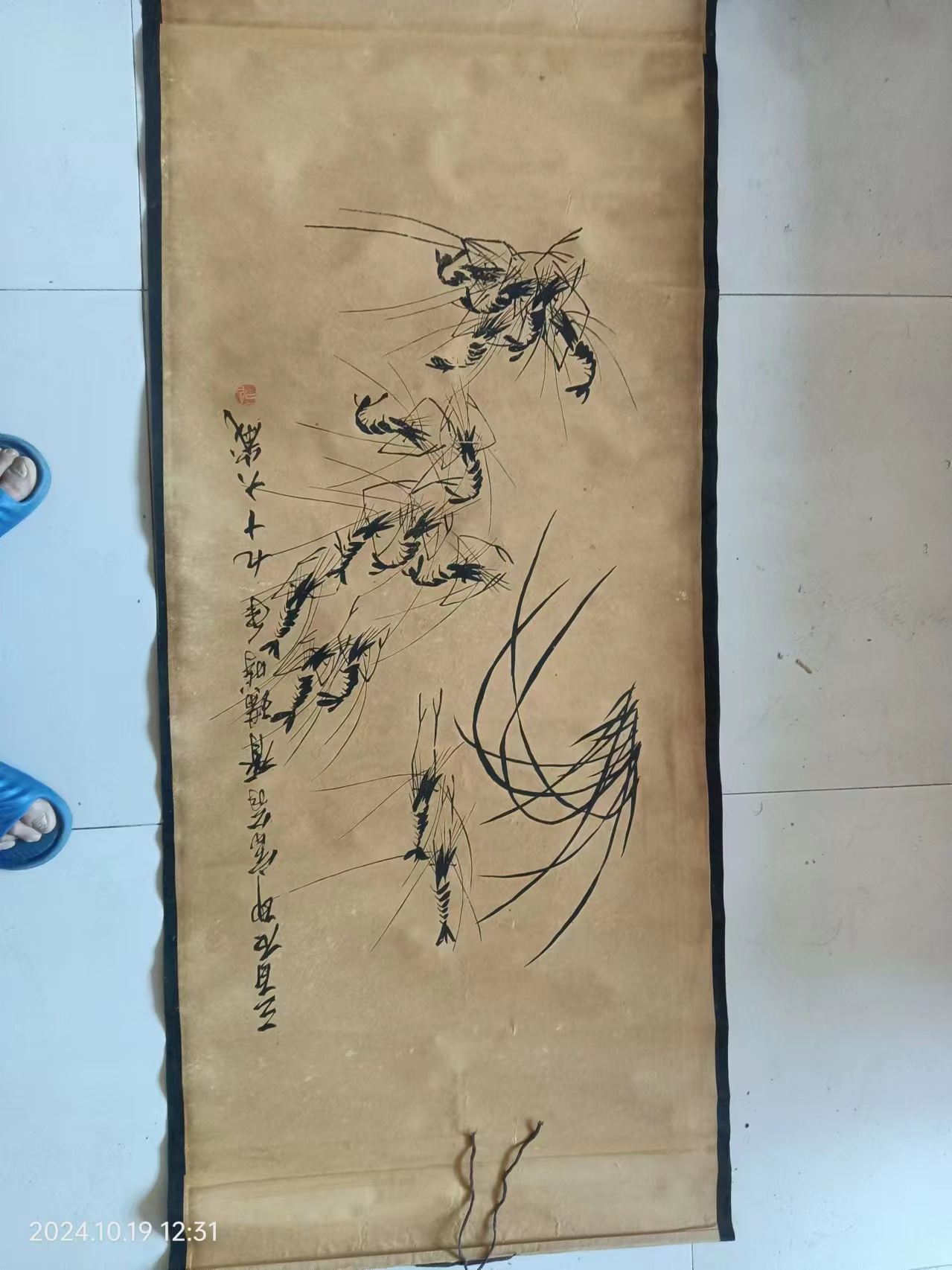齐白石于1877年做木匠学徒,次年改学雕花木工;1888年,弃凿学画,先后师从萧芗陔、文少可、胡沁园、谭溥等;1889年,师从诗人画家陈少蕃学习诗文;1894年,任笼山诗社社长。1899年,师从经学家、文学家王闿运学习诗文;1902年,出游陕西、北京、江西、广东、广西;1919年,定居北京,从陈师曾劝,始行变法;1926年,任教于国立北京艺术专门学校;1946年,赴南京、上海举办个展,并任北平艺专名誉教授;1949年,当选中国文学艺术界联合会委员、中华全国美术工作者协会委员;1952年,获聘为中央美术学院名誉教授、中央文史馆研究馆员、北京中国画研究会主席、北京中国画院名誉院长;1953年,获选为中国美术家协会主席;1954年8月,当选为中华人民共和国第一届全国人民代表大会代表;1955年12月,当选为德意志民主共和国艺术科学院通讯院士;1957年,任北京中国画院名誉院长,9月16日,在北京逝世,享年93岁。其作品也是备受藏家关注。而且书画类藏品作为收藏三大项之一,其市场关注度一直不错。近年来,由于我国加大了对文化产业的重视,导致艺术品的身价水涨船高,珍稀的艺术品其市场热门度,成交率都非常不错。投资艺术品也成为众多投资者的第一选择。所以无论从收藏角度还是经济价值角度来看,该件藏品都十分值得入手
The item is labeled as a shrimp swarm image. This work is well preserved, refined with ink, vigorous and powerful strokes, unique artistic conception, and vivid depiction of the painting. Qi Baishi (January 1, 1864- September 16, 1957), Han ethnicity, with ancestral roots in Dangshan, Suzhou, Anhui Province, was born in Xiangtan, Changsha Prefecture, Hunan Province. Ming Huang, styled Pingsheng, also known as Baishi, Baishiweng, Laobai, Jiping, Laoping, Jieshan Weng, Qida, Mujushi, and Sanbaishi Yinfu, is a modern Chinese calligrapher, painter, and seal engraver. His main paintings include "Ink Shrimp", "Cattle Herding", "Frog Sound Ten Miles Out of Mountain Spring", "Pine and Cypress High Standing Picture · Seal Script Four Character Couplets", and he has written poetry collections such as "Jieshan Yinguan Poetry Grass" and "Baishi Poetry Grass". He has also published three volume collections of "Selected Works of Qi Baishi" and "Selected Landscape Paintings of Qi Baishi".
Qi Baishi became an apprentice carpenter in 1877 and switched to woodcarving the following year; In 1888, he abandoned chiseling to study painting and successively studied under Xiao Xiangxi, Wen Shaoke, Hu Qinyuan, Tan Pu, and others; In 1889, he studied poetry and prose under the guidance of poet and painter Chen Shaofan; In 1894, he was appointed as the president of the Longshan Poetry Society. In 1899, he studied poetry and prose under the guidance of the Confucian scholar and literary figure Wang Kaiyun; In 1902, traveled to Shaanxi, Beijing, Jiangxi, Guangdong, and Guangxi; In 1919, he settled in Beijing and began implementing reforms under the persuasion of Chen Shizeng; In 1926, he taught at the National Beijing Art School; In 1946, he held solo exhibitions in Nanjing and Shanghai and served as an honorary professor at the Beiping Art School; In 1949, he was elected as a member of the China Federation of Literary and Art Circles and the All China Artists Association; In 1952, he was appointed as an honorary professor at the Central Academy of Fine Arts, a research curator at the Central Museum of Culture and History, the chairman of the Beijing Chinese Painting Research Association, and the honorary president of the Beijing Chinese Painting Academy; In 1953, he was elected as the Chairman of the China Artists Association; In August 1954, he was elected as a deputy to the First National People's Congress of the People's Republic of China; In December 1955, he was elected as a corresponding academician of the Academy of Arts and Sciences of the German Democratic Republic; In 1957, he served as the honorary president of the Beijing Chinese Academy of Painting. He passed away on September 16th in Beijing at the age of 93. His works are also highly regarded by collectors. Moreover, as one of the three major collections, calligraphy and painting collections have always received good market attention. In recent years, due to China's increased emphasis on the cultural industry, the value of artworks has skyrocketed, and rare artworks have a very high market popularity and transaction rate. Investing in art has also become the first choice for many investors. So whether from the perspective of collection or economic value, this collection is definitely worth buying





